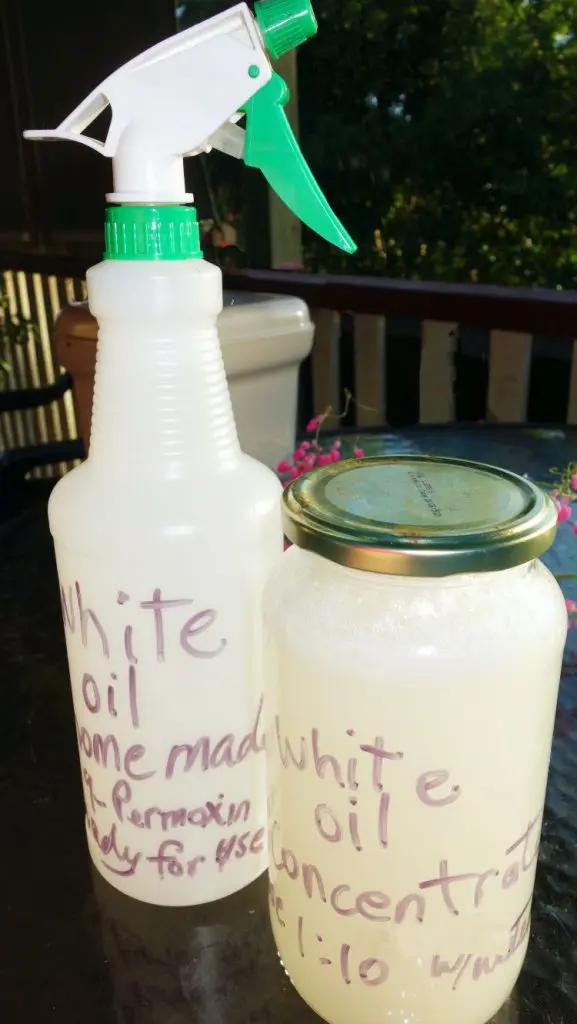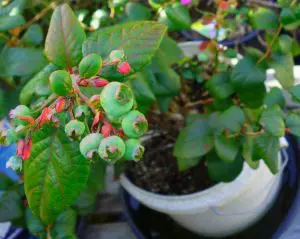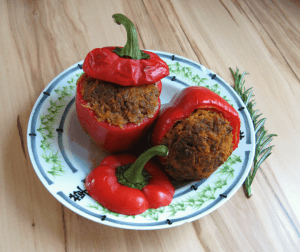White oil is a multi-purpose pest treatment that is a must-have for every food garden. It is used to combat sap-sucking and chewing insects like aphids, scale, mealy bug and citrus leaf miner. It suffocates rather than poisons these insects, so they can’t develop a resistance to it. You can buy a commercial white oil preparation, but it’s much cheaper & just as effective to make it at home.

How Does White Oil Work?
White oil is essentially a mixture of oil and soap which suffocates insects to death. The oil component works by adhering to the insect and blocks its breathing parts. Then soap then coats the whole insect which breaks down its skin. White oil is classified as a ‘non-specific contact killer’, which means that it kills every soft-bodied insect it comes into contact with. This can include beneficial insects too, so be careful when spraying it. I include a teaspoon of neem oil in my white oil recipe, because it increases the effectiveness.
One way to avoid killing the ‘good guys’ is by applying white oil with a small artists paintbrush. This is an easy method if you only a couple of small plants that need it. Use an open-top jar containing a small amount of the final reduction. This is a precise way to treat pests on small or sensitive plants.

How to Make White Oil
White oil is made into a concentrate first, then diluted with water for use. It’s important to remember that homemade insect sprays generally have no water repellent qualities, so they need to be reapplied after rain. Mix your white oil at a ratio of 10:1 with water, i.e. 10 parts tepid water to 1 part white oil.
- 1 litre (1 quart) water (room temperature or tepid)
- 1 tsp liquid soap
- one teaspoon coconut oil
- 1 tsp Neem oil
Add to a blender in this order. To combine ingredients thoroughly, blend at high speed for a few seconds.

General Tips
It’s best to only make enough diluted spray for a day or two. The older the spray in the bottle, the more oil will settle against the inside of the container. This makes it hard for the oil to re-incorporate next time you shake it.
Bring stored white oil back to room temperature before use. This allows the oil to redistribute before use. This is especially important if using coconut oil in your recipe, since it becomes solid at 21 degreesC.
It’s best to have a dedicated blender for making garden sprays. This is because some of the ingredients such as soap and Neem are non-food. Both can be very hard to remove from the blenders plastic components. I use a stick blender which has multiple whisks, and keep one set of the whisks specially for non-food use.
Use only hand or facial liquid soap for making white oil. Hand and face soaps are plant oil-based, being made using potassium hydroxide with vegetable oil. More expensive or certified organic brands will contain coconut or olive oil, which are better again. A small pack of organic handsoap will last years at just one teaspoon per batch. Note that dish washing liquid is animal-based, usually made with sodium hydroxide plus an animal fat derivative of some sort.
Use xanthan gum as a stabiliser if your mixture separates too much. Because oil and water don’t naturally mix, I add xanthan gum powder which helps them combine. Xanthan gum is widely used in food and garden preparations, as it distributes the oil evenly throughout the liquid and stabilises the suspension. You only need a tiny bit -half a teaspoon- and it’s added just prior to blending. I’ve not included it on the ingredients list above, as it’s optional.

Using Xanthan Gum
It’s important to remember that a little bit of xanthan gum goes a long way, and it is highly dose-sensitive. The amount of xanthan gum may differ between recipes because not all neem oils, vegetable oils, hand soaps and face soaps are created equal.
Measuring xanthan gum can be done in two different ways. You can use a set of purpose-made measuring spoons, or a dry teaspoon & a butter knife. I also use a little plastic box to catch the xanthan gum when I divide my teaspoonful in half, as shown in the photo above.
Dip the teaspoon into the gum powder, pressing gently against the inside of the bag, so the measured amount fills the spoon evenly to the edges. Now you have ‘1 teaspoon firmly packed’. Using the knife, cut down the middle of the teaspoon of powder and gently wipe half the product into the little plastic box. Now you have exactly half a teaspoon of xanthan gum. Add just before blending.

Patch Testing
Once you’ve made your white oil, do a patch test first to make sure it doesn’t cause any damage to sensitive plants. Choose a young leaf and paint some white oil on it with a small artists brush. Place the plant in the shade and wait an hour or so. If the leaf still has good integrity after this time, you can safely spray or paint the plant with your white oil.
If your recipe turns out to be too strong, measure out a tablespoon of concentrate & mix it with 20 tablespoons of tepid water. Shake well and test the mixture out. This dilution will create a ratio of 1:20, which is half the usual strength. Use the remaining full strength product (i.e. 1:10) on more robust plants.

One last reminder- don’t forget to label your bottles. Even though home-made remedies are best used fresh, sometimes we do store them. In this case, make sure you label your bottles so you remember which is which!











